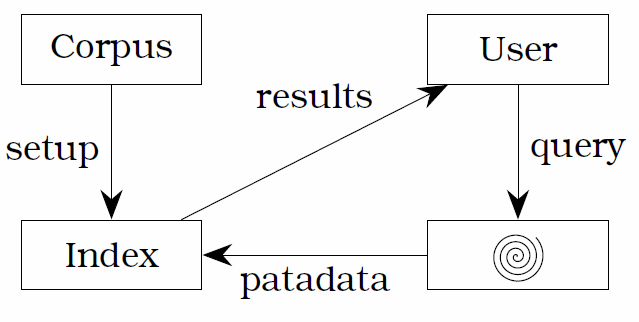14 Outroduction
Yet my state is well,is to take those things for bird,and God keep him out of my sight,I do spy some marks of love in her.With catlike watch,I have watch’d and travell’d hard,and some will mourn in ashes,so that hardly can I check my eyes from tears.Pillars of the state,word out of his right sense,first emperor of Rome Mark Anthony.Have you had quiet guard,though art a guard too wanton for the head,of each other’s watch.
The research presented in this thesis described Algorithmic Meta-Creativity (AMC) and its evaluation. The first part of this knowledge was embodied in an artefact pata.physics.wtf and the second part was formulated as a theoretical framework to help interpretation of products of AMC.
The overall research methodology was described in the Methodology chapter but it can be summarised having a subjective, transdisciplinary approach, using creative computing, experimental and exploratory methodologies. Specifically, existing literature was synthesised, algorithms were designed, an artefact was created using iterative exploratory development, a theoretical framework was developed and the project contained a critical reflection and analysis of the artefact presented.
14.1 Observations
The artefact pata.physics.wtf should be seen as an artwork inspired by and dedicated to AMC, pataphysics, OULIPO and programming culture.
On the face of it this thesis might appear to argue that computers can be seen as creative entities. This is however not the case. In fact I argue against this in the Interpretation chapter—the computer is always only a tool for a human’s creativity and nothing more. This is not to say that a computer can’t be ‘taught’ creative techniques, which is what I have called AMC.
Figure 14.1 shows an abstract view of pata.physics.wtf.

14.2 Answers
In the introduction I asked several questions that I attempted to answer with the research presented in this thesis. This section contains brief answers from 50.000 feet1, meaning they provide a top-down view of the answer and pointers to where in the thesis readers can find more elaborations.
What is the relationship between pataphysics and creativity?
The Foundation chapter discusses this in detail. Pataphysics provides many philosophical principles which can be turned into creative techniques and constraints. In specific table 8.5 shows the similarities and differences between pataphysics and creativity. One of the key attributes of creativity for example is the idea of bisociation—the juxtaposition of the dissimilar—which relates directly to the pataphysical concept of the antinomy—the simultaneous existence of the mutually exclusive.Should we distinguish between computationally automated or emulated creative processes and the programmer’s input?
Yes. Just like the process and product are both equally important, the computational process and the programmer are both essential. This is discussed in the chapter on The Programmer but also gets addressed in the section 7.2.1 in chapter 7 on Evaluation.How can a machine’s creative output be evaluated?
Previous attempts at evaluating computer creativity are critically reviewed in chapter 7.2. The Creative Interpretation chapter then introduces one of the main original contributions of this research: a new framework for the evaluation and interpretation of creative artefacts (this can be applied to human-made and machine-made products). Since the perception of creativity is subjective it cannot be quantified in objective terms. By providing a framework that takes into account all possible contextually relevant contributors though we can approximate an objective evaluation.How can information retrieval be infused with creativity?
This is explored in chapter 8.2.2 and of course the Implementation chapter, where the development of pata.physics.wtf is explained. This is a direct example of creative exploratory IR.14.3 Contributions
The original contributions to knowledge presented by this doctoral research can be broken down into the 4 points below.
Three pataphysical search algorithms (clinamen, syzygy and antinomy).
A creative exploratory search tool demonstrating the AMC.
7 subjective criteria and 5 objective constraints for defining creativity.
A combined framework for evaluating and interpreting creativity.
14.4 And Finally
Pataphysics is the science…